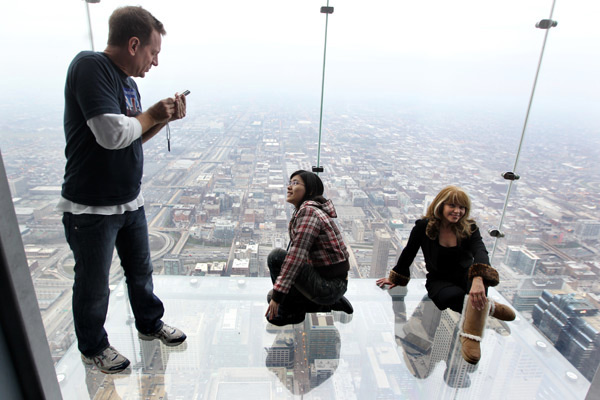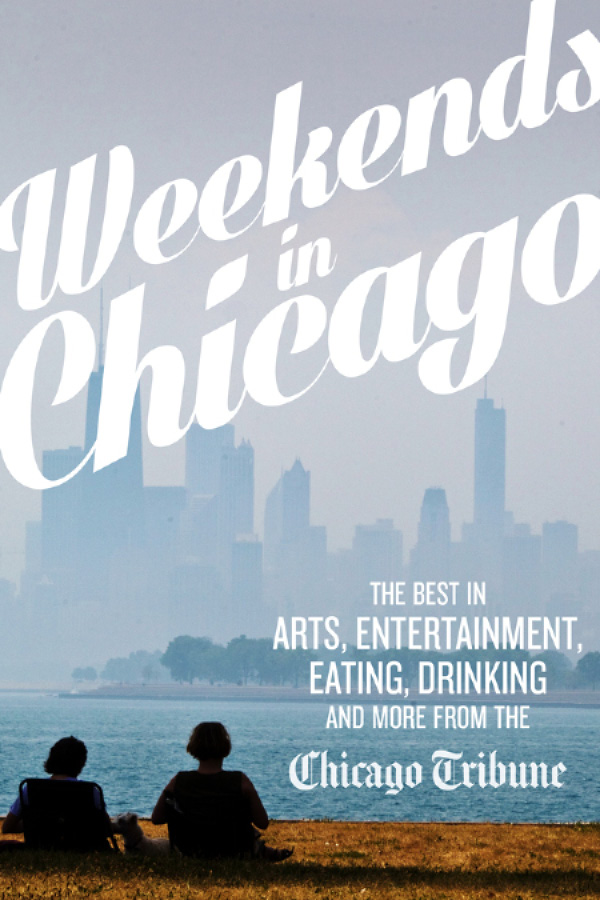This book was created using articles and reviews published in the Chicago Tribune. Articles were carefully edited in order to guide the reader to some of the best this city has to offer. You may encounter information written in different points of view; our aim was to preserve the writers original perspectives. Italicized text was written by the editor.
FOR THE ARCHITECTURE ENTHUSIAST

This enclosed glass ledge juts out from the 103rd floor of Willis Tower, the tallest building in the United States.
WHERE TO GO DURING THE DAY
As the home of some of the earliest skyscrapers and famed architects and designers, Chicago has endless opportunities to view and study renowned architectural masterpieces. Head to the Willis Tower Skydeck during day or night, whichever is preferable.
GO TO THE TALLEST BUILDING IN NORTH AMERICA
Willis Tower Skydeck Ledge
Show off your fearlessness on the glass boxes that extend 4 feet out from the towers 103rd floor. This spot will make you feel as if youre floating on air (and give you a perfect excuse to hold your dates hand). Your tickets will also give you access to videos and graphic presentations about Chicagos culture and architecture as you wait to reach the top. Be warned: Lines can be long. But the view could have your date pre-planning your next bonding session on the way back to the ground.
233 S. Wacker Drive
312-875-9696
theskydeck.com
SCHEDULE AN ARCHITECTURE TOUR
Chicago Architecture Foundation River Cruise
The marquee river tour shows off what docent Don Wiberg called our museum of skyscrapers on a journey that goes as far as Goose Island on the North Branch, and down to the Thermal Chicago Building (crucial for cooling todays glass-enrobed towers) on the South Branch.
Ive done this tour a few times with visiting guests, and while they try to be agnostic, the CAF docents tend to have their favorites. Harry Weese got several shout-outs from Wiberg, from his whimsical (and nautical) river cottages and Fulton House condominiums on North Canal to his one-man drive to save Printers Row.
In an ironic twist, Wiberg noted that the building that once housed 19th-century catalog-retail pioneer Montgomery Ward now contains the offices for Groupon. Such associations between the past and the present crop up frequently as you gaze upon the historic and the modern, set side-by-side. There is also at least one grim reminder of our current economy in the form of the hole in the ground from whence Santiago Calatravas Chicago Spire would, in flusher times, have been corkscrewing skyward.
The CAF offers multiple boat tours daily, departing from the boat docks at the southeast side of the Michigan Avenue Bridge.
The Chicago Architecture Foundation
224 S. Michigan Ave.
Chicago, IL 60604
312-922-3432
architecture.org
Historic Downtown: Rise of the Skyscraper
The Chicago Architecture Foundation offers an array of walking tours, as well as tours by bus, trolley and that famous river cruise. Choosing among the more than 85 options can be daunting, so I started at the beginning, historically speaking, with a tour through the early days of the skyscraper in the South Loop.
Our volunteer docent, Marlene Stein, took seven of us to see more than a dozen early skyscrapers, all built between 1871s Great Fire and 1930s art deco heyday. (The Harold Washington Library was the one contemporary ringer in the bunch.) The international appeal of Chicagos architecture was apparent. I was outnumbered by visitors from Singapore, Switzerland, Chile, Denver and Madison, Wis.
Stein began by explaining that the very building that houses the architecture foundation (1904s Railway Exchange Building) contains the penthouse where Daniel Burnham and his associates drew up the 1909 Plan of Chicago. The buildings steel-frame construction, floating foundations and terra cotta exterior (imported from exotic Joliet) also mark it as a fine example of its time.
The tour includes indoor stops. I was amazed (and more than a little embarrassed) to realize Id never before set foot in the lobby of the 1895 Marquette Building. Then I was amazed and outraged to learn that the relief sculpture of the buildings namesake, Father Jacques Marquette, was left unsigned by artist Amy Aldis Bradley. According to Stein, a womans name on the work wouldnt have been welcome, so Bradleys contribution sits anonymously amid the Tiffany mosaics.
The Chicago Architecture Foundation
224 S. Michigan Ave.
Chicago, IL 60604
312-922-3432
architecture.org
VISIT FAMOUS HOMES IN CHICAGOLAND
Frank Lloyd Wright Home and Studio
Of course no one can fully appreciate Wrights contributions without visiting his Oak Park residence, where he drafted his plans for the Robie house and which he used as a laboratory for his developing ideas about domestic design. (He also raised six kids here, but its safe to say that family man wouldnt be the top accolade on the list of Wrights achievements.)
951 W. Chicago Ave., Oak Park
312-994-4000
gowright.org
Frederick C. Robie House
A full area tour of the Wright stuff takes one to Hyde Park and the Prairie-style masterpiece created for businessman Robie, completed in 1910. The home is open to the public as it undergoes further restoration.
5757 S. Woodlawn Ave.
312-994-4000
gowright.org
Charnley-Persky House Museum
The Charnley-Persky home, designed by Louis Sullivan in 1891, is one of the few surviving buildings that shows off the talents of both Sullivan and his unruly disciple, Frank Lloyd Wright. Built for James Charnley, a Chicago lumberman, and restored through the generosity of Seymour H. Persky, the home was described by Wright himself as the first modern house in America and provided an early example of what would become his signature style.
1365 N. Astor St.
312-573-1365
charnleyhouse.org
Clarke House Museum
As the oldest standing house in Chicago, the 1836 Greek Revival residence originally built for upstate New York transplants Henry and Caroline Clarke deserves a look-see. After many perambulations, it now rests about two blocks south of its original location, nestled in the bucolic surroundings of the Chicago Womens Park and Gardens in the Prairie Avenue Historic District. On a recent Saturday tour, docent Robert Irving pointed out the ways in which the home and its fixtures (the latter donated through the Colonial Dames of America, as no original pieces have survived) benefited from the Industrial Revolution. The construction itself uses timber framing, rather than the balloon frame method which dominated during the first boom years in young Chicago, but Irving wryly observed that the homes decor industrial carpets, pressed-glass stemware, et al. could serve as the model for the fashionable 19th-century House Beautiful derided by Mark Twain in Life on the Mississippi. However, any home that can withstand being moved over L tracks in the dead of winter, as the Clarke House was in 1977, need not apologize for itself.






